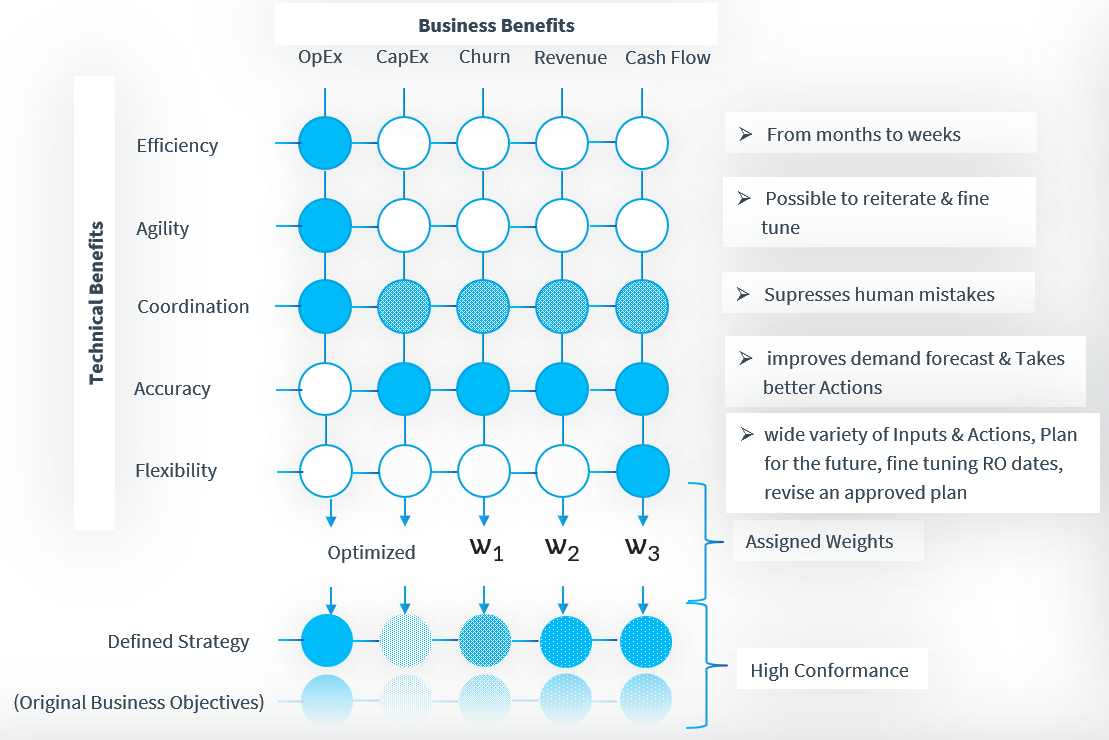The Agony of Traditional Planning
Planning is indeed a cumbersome activity. It requires the involvement of many parts of the CSP organization with many people. It starts at the top where business objectives are defined by upper management, and this then proliferates downwards through investment strategy that coordinate the activity together with the various distributed technical teams. Depending on the size of the network this could mean from 50 to well over a 100 people involved. The quality and transparency of the inputs and feedback will vary depending on the individual experiences of the participants and may be somewhat obscured by the ambitions and subjective views of the different teams and regions. To complicate things further the business objectives will be multifaceted. They will be a blend of goals where the priority of one over the other may be overlooked by the different entities. For instance, if an operator wishes to prioritize resolving customer complaints with a very high priority then this may be at the expense of other possible benefits if there is a budget constraint setting. A complaint area may not be an area where there are a lot of other users for instance. Then there is the guess work. There will be management and interpretation of a considerable amount of inadequate data. The tools used here will be typically excel based or some form of light code or scripts at best. This is just a glimpse of the problems that traditional planning faces. So, what benefits can a digital smart planning solution provide and how can it change the activity altogether such to provide high quality outputs that lead to efficiencies in CapEx, OpEx, Churn and Revenue?
Digitalized Smart Planning
There are many contributors to the advantages of performing digitalized smart planning. The latter can be grouped into those that provide higher operational efficiency, and those that can introduce some new benefits such as reduced churn, improved ROI and even CapEx efficiency.
- Efficiency - The most obvious benefit derives from the automation aspect, which like all digital automation introduces efficiency that will yield in operational savings. Automated planning will ensure that a detailed plan can be completed within weeks rather than months ensuring that the plan is still valid by the time it is out. This by itself will ensure better ROI and less churn as it will be more accurate compared to manually built plans.
- Agility - Automation will also introduce agility and provide the ability to perform quick iterations changing the planning process altogether. While typically a plan normally takes several months to finalize, automation can allow several iterations to be run with slight revisions over the original strategy before a final decision is made for implementation, thereby fine tuning the investment strategy and even the business objectives themselves. This ability can transform the process of planning altogether allowing to reach new insights with each iteration. Although, efficiency is granted with such a tool, the ability to exploit this trait across the different layers of an organization really depends on a decision to adopt it.
- Coordination - A unified planning tool will ensure that by following a coordinated predefined methodology of all the workflows in the planning process every intended input will get the desired amount of attention and will limit human errors, misinterpretations and any biased views that may have crept into the analysis.
- Accuracy – A critical aspect of a digitalized planning algorithm is how accurate it is. This is predominantly determined firstly by how well it is able to predict the demand. Typically, the longer the data goes back in history and the better the prediction accuracy. Multiple years of historical data is required to capture variations related to seasonal changes, for instance. Some operators do not necessarily have data that extends back in time to the extent that is required for this purpose. In this case, backcasting can be done to compensate for that. Secondly, and even more importantly is how intelligently it is able to decide on what action to take and where to take it in order to fulfill a capacity gap in the network. These two areas are where AI based algorithms provide a major benefit that can analyze a vast number of inputs and provide an intelligent output. Last but not least, it is equally important to downgrade or remove capacity in areas that are seeing a reduction in traffic, or in areas where traffic is carried over by a newly planned upgrade in the same vicinity.
- Demand Forecasting: An AI based forecasting engine generates the demand forecast for the network based on collected historical data, following a comprehensive data treatment process with multiple phases.
- Requirement Analysis: A set of technical and financial requirements are collected. On the technical side, the QoS/SLA requirements for a certain application are a key requirement. On the financial side, all the costs for a given capacity upgrade/downgrade action for each vendor and the total budget for a given period are essential.
- Strategy Definition: A strategy is defined based on all the considered criteria to use with a prioritization and weighting scheme for each.
- Capacity Planning: Using AI based techniques, the forecasted capacity requirements are mapped to one or multiple actions after having converged on the best option that fulfills a defined strategy within some associated limits such as the budget, time period and RO plan
- Reporting: A set of reports are generated that show the details of the all the taken actions as well as a business summary with all the financials.
To wrap up, it is essential to understand that the actual types of business benefits and their gains that will be obtained from a capacity planning product will vary depending on the set strategy by the operator for any given plan. P.I. Works SmartPlan will ensure the plan remains focused and constrained to within the original business objectives free from mistakes, misinterpretations, subjective views and lost time using highly accurate algorithms, on a consistent basis (The Figure below provides a high-level approximation of the value matrix offered by SmartPlan. In reality, many different inputs are used in the analysis including coverage heatmaps, and preferred site locations).

P.I. Works is best known for providing positive results in the field that stems from a combined synergy that comes from its products and its experienced services organization supporting projects world-wide in tandem fashion. SmartPlan is no exception. P.I. Works seasoned consultants provide regular feedback on new ideas for improving its product solutions from different perspectives. Their dealing in providing professional services and managed services contribute to a wide range of insights that serve to enrich product capabilities from different angles for further improving efficiency and providing better results in the field. One example of this is that not all project cases have sufficient amount of network data to provide a solution for resolving a problem in an ideal manner. In this case intelligent work arounds to a default approach are incorporated into the algorithms in order to provide robustness against such shortages.


